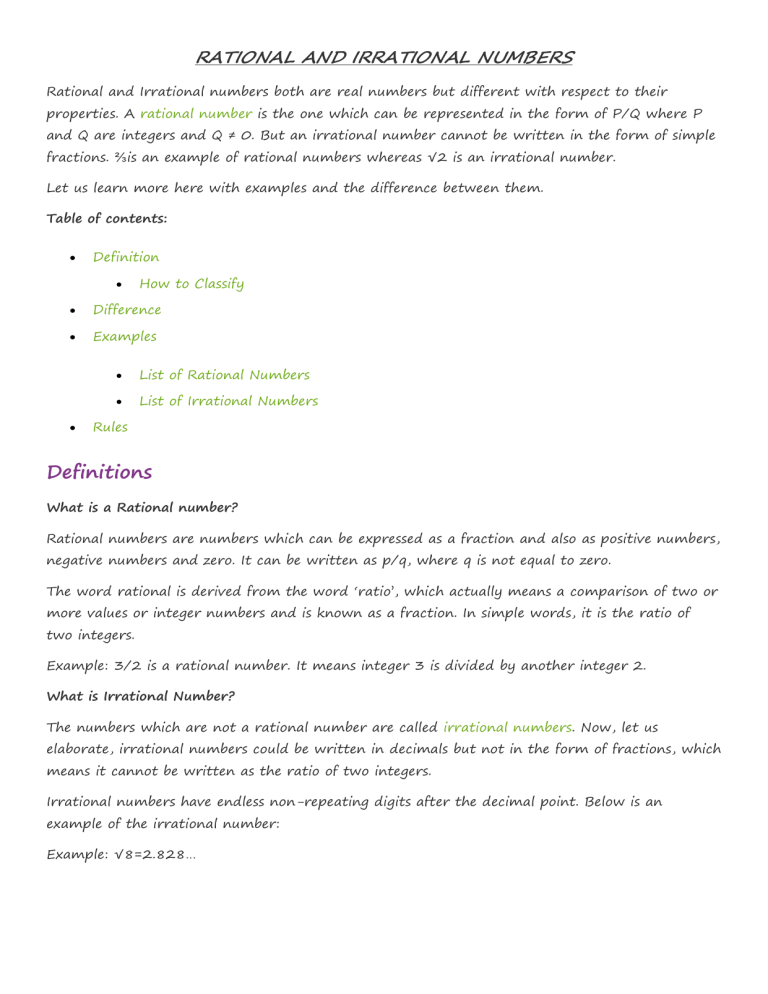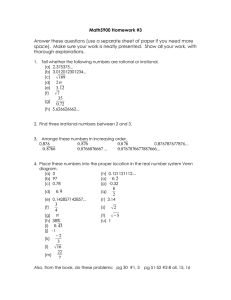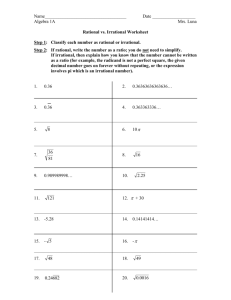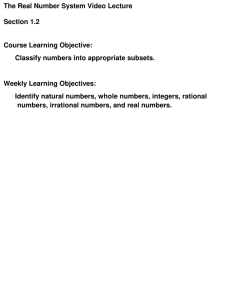
RATIONAL AND IRRATIONAL NUMBERS Rational and Irrational numbers both are real numbers but different with respect to their properties. A rational number is the one which can be represented in the form of P/Q where P and Q are integers and Q ≠ 0. But an irrational number cannot be written in the form of simple fractions. ⅔ is an example of rational numbers whereas √2 is an irrational number. Let us learn more here with examples and the difference between them. Table of contents: Definition How to Classify Difference Examples List of Rational Numbers List of Irrational Numbers Rules Definitions What is a Rational number? Rational numbers are numbers which can be expressed as a fraction and also as positive numbers, negative numbers and zero. It can be written as p/q, where q is not equal to zero. The word rational is derived from the word ‘ratio’, which actually means a comparison of two or more values or integer numbers and is known as a fraction. In simple words, it is the ratio of two integers. Example: 3/2 is a rational number. It means integer 3 is divided by another integer 2. What is Irrational Number? The numbers which are not a rational number are called irrational numbers. Now, let us elaborate, irrational numbers could be written in decimals but not in the form of fractions, which means it cannot be written as the ratio of two integers. Irrational numbers have endless non-repeating digits after the decimal point. Below is an example of the irrational number: Example: √8=2.828… How to Classify Rational and Irrational Numbers? Let us see how to identify rational and irrational numbers based on the given set of examples. As per the definition, the rational numbers include all integers, fractions and repeating decimals. For every rational number, we can write them in the form of p/q, where p and q are integers value. Venn Diagram The below image shows the Venn diagram of rational and irrational numbers which come under real numbers. Difference Between Rational and Irrational Numbers It is expressed in the ratio, where both numerator and denominator are the whole numbers It is impossible to express irrational numbers as fractions or in a ratio of two integers It includes perfect squares It includes surds The decimal expansion for rational number executes finite or recurring decimals Here, non-terminating and non-recurring decimals are executed Also, read: Difference Between Rational Numbers And Irrational Numbers Examples A list of examples of rational and irrational numbers are given here. Examples of Rational Numbers Number 9 can be written as 9/1 where 9 and 1 both are integers. 0.5 can be written as ½, 5/10 or 10/20 and in the form of all termination decimals. √81 is a rational number, as it can be simplified to 9 and can be expressed as 9/1. 0.7777777 is recurring decimals and is a rational number Examples of Irrational Numbers Similarly, as we have already defined that irrational numbers cannot be expressed in fraction or ratio form, let us understand the concepts with a few examples. 5/0 is an irrational number, with the denominator as zero. π is an irrational number which has value 3.142…and is a never-ending and nonrepeating number. √2 is an irrational number, as it cannot be simplified. 0.212112111…is a rational number as it is non-recurring and non-terminating. There are a lot more examples apart from the above-given examples, which differentiate rational numbers and irrational numbers. Properties of Rational and Irrational Numbers Here are some rules based on arithmetic operations such as addition and multiplication performed on the rational number and irrational number. #Rule 1: The sum of two rational numbers is also rational. Example: 1/2 + 1/3 = (3+2)/6 = 5/6 #Rule 2: The product of two rational number is rational. Example: 1/2 x 1/3 = 1/6 #Rule 3: The sum of two irrational numbers is not always irrational. Example: √2+√2 = 2√2 is irrational 2+2√5+(-2√5) = 2 is rational #Rule 4: The product of two irrational numbers is not always irrational. Example: √2 x √3 = √6 (Irrational) √2 x √2 = √4 = 2 (Rational)




